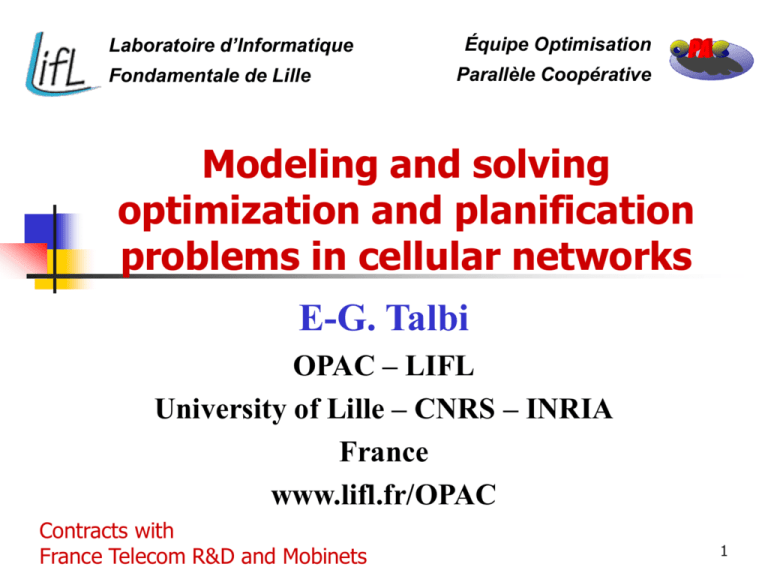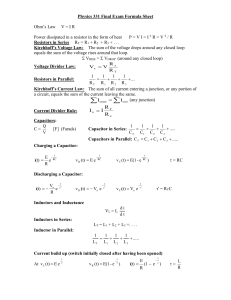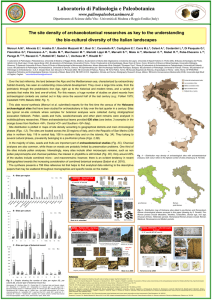A(1) - Gforge
advertisement

Laboratoire d’Informatique Fondamentale de Lille Équipe Optimisation Parallèle Coopérative Modeling and solving optimization and planification problems in cellular networks E-G. Talbi OPAC – LIFL University of Lille – CNRS – INRIA France www.lifl.fr/OPAC Contracts with France Telecom R&D and Mobinets 1 Cellular Network Planning and Optimization Frequency Assignment (FT R&D) Access Network Design and Planification (Mobinets) Radio network design (FT R&D) Location Area planification (Mobinets) Modeling (mono-objective and multiobjective mathematical programming models) Hybrid Metaheuristics (local search, EAs, etc.) Parallel Algorithms Source : http://www.ulg.ac.be/telecom/publi/publications/mvd/Demoulin2004Principes/ 2 Access Network Design From 2G to 2.5G and 3G Networks … Operators to be competitive and economical (Major Cost : 1/3 of the total cost) Transmission costs are becoming high compared to the equipment costs Traffic demands are increasing with the introduction of new services 3 Access network design to the RTCP HLR Objectives : cost, availability Constraints : traffic, capacity, hops, … Radio sub-network VLR MSC BSC BTS T-Mobile & Mobinets GSM UMTS 4 Constraints (1) (2) (3) (4) (5) (6) (7) Dealing with spanning trees, Depth of the tree, BSC / BTS / DXX degree, BSC / BTS / DXX traffic capacity, BTS availability, DXX locations, Predefined links. 5 Objectives (1) Minimize the total cost, min . Li N cost ( Li ) Di N cost ( Di ) (2) Maximize the overall availability max . Li N avail.( Li ) V 6 Complexity The constrained minimum spanning tree NP hard Number of candidate topologies V V 1 L X 1 V V ( Supposing first DXXs could only be colocated with some BTS sites ) 7 Algorithms Greedy Heuristics : Inspired from Prim and Kruskal Local Search Evolutionary Algorithm Hybrid algorithm (Genetic algorithm, Kruskal, Local search) 8 Performance Evaluation Instance gsm1 gsm2 gsm3 gsm4 gsm5 Prim 116971 119724 138303 104775 124848 Average 116062 115798 138391 101950 124554 Worst 130035 126302 157024 119650 146874 Best 109803 111769 129310 97537 115507 Average 110205 113831 135341 98586 118697 Worst 112288 115525 137628 99548 121685 Best 108945 112111 131438 97515 115856 Average 108666 111803 129534 97066 116268 Worst 109430 112111 131415 97168 117868 Best 108223 111764 129310 97001 115475 Local Search Genetic Algo. Hybrid Algo • Both cost and robustness have been improved. • Variance between worst and best computed topologies is low.9 Best computed maps (gsm3) 10 Location Areas Planning and Optimisation MSC (Mobile Switching Center) BSC (Base Station Controller) Cells 11 Location Areas Planning and Optimisation BSCs associated to MSCs Cells associated to BSCs Location area : To localize the user 12 Location Areas Planning and Optimisation 1 service area = Associated to a MSC Sub-set of network cells Connected group 1 location area = Inside a service zone Sub-set of network cells Connected group 13 Location Areas Planning and Optimisation When a mobile changes a location area Updates its position Find a good compromise between paging and location area update 14 Some constraints Topological Constraints : A cell is affected to one BSC A BSC is affected to one MSC A cell is in a single LA A LA is an single SA Two areas are in two different LA Connexity constraints Technical Constraints (MSCs, BSCs, LAs): Maximal traffic handled (Erlang) Maximal number of transmitters (TRX) Maximal number of administration canals (SDCCH) Maximum number of tentative calls (MT-BHCA/PAG), Maximal number of cells 15 Objectives Minimize the location area (lup) inter-MSC min f v w Minimize the location area (lup) intra-MSC min d v l vw vw l vw vw w Minimize the traffic of signalisation (paging) min pv pw 1 d vw vV wV 16 Solving strategies Different sub-problems : Partitioning in SA Partitioning in LA Assignment of BSCs to MSCs Assignment of Cells to BSCs Inspired from Clustering techniques Genetic algorithms (coding, crossover, random immigrants, …) Local search Hybrid algorithms (GAs, KNN) 17 Some results for hybrid approach Evolution of the population Mutation, Mutation PPV, Random Immigrant 12100000 12000000 Meilleur Individu 11900000 Moyenne des Individus 11800000 331 298 265 232 199 166 133 100 67 11700000 34 Good compromise between diversification and intensification Interesting results comparing to other algorithms 1 Fitness of the best Individual : 11759200 18 Radio Network Design Radio network design : Multi-objective modelization A Pareto evolutionary metaheuristic Elitism, « Sharing », Hybridization. Performance evaluation Parallel models : cooperative, parallel evaluation, … Results analysis Conclusions & Perspectives 19 Radio telecommunications networks Design challenges Network cost : number of sites,… Quality of service : traffic, interferences, … Network design Positioning of BTS Configuration of BTS (TRX, antenna, …) One site : From 1 to 3 BTS per site BTS : Base Transceiver Station 20 Cellular network design Existing tools Micro-cellular networks WISE of ATT Manual or semi-automatic design « Simplified » modelization (hexagonal cells, …) Thesis of P. Reininger (FT R&D) Macro-cellular networks MACRO INTERIOR European projects STORM : mono-objective (minimization of sites, restrictive configuration) ARNO : non-Pareto (agregation), Genetic algorithms, simulated annealing, tabu search, … PUBLIC ZONE MIC RO MOBILE RESIDENCE 21 Environment – Instance data Discrete geographical area (grid) : Different set of test points Reception (RTP) Service (STP) Traffic (TTP) RΤRTi / RTiP,i SΤSTi /STiP,i TΤTTi /TTiP,i (Cd_ij) (Cd_ij>Sq) (E_i) A set of potential sites LLj / LjP,i P 22 Configuration of antennas Data Ps Diagram Height Azimuth V Tilt TRX Bounds [26, 55] dBm 3 types [30, 50] m [0, 359] ° [-15, 0] ° [1, 7] Complex combinatorial problem : ~ 600.109 solutions per antenna 1 omni or 1-3 directive 23 Effects of configuration Cell = covered region by a BTS Propagation model used : Free space Omni-directional 60 dBm Azimuth 50° Directive type 1 Directive type 2 PIRE -10 dBm Tilt -15° 24 Multi-objective model: Constraints A set of BTS satisfying the constraints : Covering STPi is covered if P Cdij S q , j Handover (mobility) For each cell: Cdij Cdij' HandC j Ri : Cdij S q and L j ' / Cdij Cdij ' 7 HandC j 25 Multi-objective model: Objectives Min Number of sites (cost) min jL y jc j Min Interferences 1, yj 0, if L j is used else STi : Cdijk Cdiu 1v 1 ... Cdiuh vh Cdiuh1vh1 ... Sm Handover sets (4 first signals) min iSTi i où i Max Traffic hold max ei x'ijk , j iR Interferences sets (nuisibles) Cd PCd iuvI 4 Sm iuv Geographical area Used Sites Non-used sites Handover zone Covered zone 1, if xijk 1 and ei 0, xijk else 0, 26 Multi-objective optimization Dominance y dominates z iff i[1..n], yizi et i[1..n], yizi Pareto Optimality Solution x *C is Pareto optimal iff there is no solution xC Such that F(x) dominates F(x*) f1 Pareto optimal solution (efficient, non dominated) z y Dominated feasible solution f2 PO : Set of Pareto solutions 27 Multi-objective algorithms Metaheuristic Multiobjective Pareto Uni-objective Agregation method -constraint method Goal programming Populationbased Single solution Genetic algorithm Scatter search Ant colony Tabu-search simulated annealing Exact methods: small size, bi-criteria problems Mono-objective methods require A-priori knowledge (weight, constraints, goal) and modify the structure of the problem (convexity, ...) Pareto approach generates a set of Pareto solutions (even those in concave regions) Population-based metaheuristics are suited to Pareto approach 28 Pareto Approch Goals Diversification : sharing,… Convergence : ranking (order between individuals), elitism,… f f 2 Feasible solutions 2 Feasible solutions f 1 Solution found f Pareto front 29 1 Pareto Evolutionary Algorithm Population Replacement Genetic operators Update archive Elitism Evaluation Selection « Ranking » f « Sharing » 2 A(1) Ranking NSGA H(3) Archive Pareto F(2) R3 B(1) C(1) Efficiency of Pareto mechanisms: Ranking, Elitism MO Knapsack : I. Kort (Concordia) R1 G(2) D(1) R2 E(1) f 30 1 Encoding of individuals An individual encodes/represents a whole network Hierarchical encoding (4 levels) Level Gene 1 Gene 2 1 Site 1 (0/1) 2 Omni/Dire c ... Site N (0/1) An individual Station 1/3 (0/1) 3 4 Site 2 (0/1) Power Azimut Azimut Azimuth Diagramme Diagramme Diagram Inclinaison Inclinaison Tilt Puissance Puissance Power Constraint : 1 to 3 directive antennas OR 1 omnidirectional antenna 31 Crossover and Mutation operators Geographic Crossover Radius R around a site S (randomly chosen) Exchange of sites (level 1) Site Omni/direc t Station 1/3 Multi-level Mutation Power Diagram Azimuth Power Tilt Activation of a site OR type and number of antennas OR antenna parameters 32 Sharing function f2 Penalize the individual fitness / number of similar individuals Niche count m( x ) shdist( x, y ) f ' ( x) yPop. sh sh f1 1 dist x , y sh dist x, y 0 sh f ( x) m( x ) If dist ( x, y ) sh 1 Otherwise sh dist Objective space and/or Decision space (x,y) ? Objective Combined Sharing (objective, decision) : flow-shop scheduling (Phd. M. Basseur) Used Metric (dist) ? : Euclidean distance 33 Adaptive niche size : sh M3,m1 share n1 AirePareto N M2,m3 M1,m2 f3 sh f2 f1 34 Constraints : Linear Penalization Penalization / Constraint violation Covering Handover Pc 1 0 0 Pho 1 0 80 100% covering 5* Pc cover 100 0 2 * handover Ph 100 0 0 50 100% handover 4 if 4 cover >80 % otherwise if handover > 50 % otherwise 35 Cost function : Pareto Rank Penalization of constraints (Handover and Covering) and sharing are applied for each objective (traffic, interferences and number of sites) Ph(u)*Pc(u) f (u) f(u)* m(u) ' Cost(Solution) = Rang_Pareto(penalized objectives) Pareto Rank (number of dominating solutions) has to be minimized 36 Experimental Protocol Instance 1 : Highway 250 sites, Traffic : 3210 Erlang Sites 36 49 70 Interf Trafic (%) 228000 72 483542 97 602930 99,75 Instance 2 : Urban zone 568 sites, Traffic : 2988 Erlang 32 sites 61 sites (cells) (interferences) 37 Performance Evaluation Few works in the literature realize quantitative evaluation Exact representation of Pareto front PO [J. Teghem ’98, …] Approximation of PO : 2 complementary measures Contribution, Entropy Contribution : Compares the dominance C: common solutions W1: PO1 > PO2 L1: PO2 > PO1 N1 : non-dominated PO1 PO2 C C C W1 N1 2 CONT(PO1/ PO2) C W1 N1 W2 N2 L1 W1 W2 L2 N1 N2 Ex: If PO1=PO2 Then CONT(PO1/PO2) = 0.5 If PO1>PO2 Then CONT(PO1/PO2) = 1 38 Entropy : Diversity We define a niche for each solution of PO*=Non-Dominated(PO1 U PO2) E(PO1,PO2) : diversity of solutions of PO1 relatively to niches of PO* PO* E(PO1,PO2) 1 ( 1 ni ln ni ) ln( ) i1 Ni PO1 PO1 PO1 PO2 Niches 39 Impact of sharing Entropy Contribution 0.95 Sharing Sans Sharing 0.42 Non-hold Traffic (%) Number of sites 0.63 0.36 Without sharing With sharing Interferences Convexity (sharing) : mean of 55% of the front on the convex hull 40 Hybridization : Principle Goal : Improve the approximation found by the Genetic Algorithm GA LS Principe : Use the GA to approximate the Pareto front (exploration by GA). Use a Local Search method to intensify the search. 41 Hybridization oriented by the archive Archive Population Archive GA Local Search Local Search Pareto Solutions Pareto Solutions Archive Archive LS Pareto flow-shop scheduling and vehicle routing (Phd M.Basseur and N. Jozefowiez) Restricted Neighborhood Nb Sites Interferences Before After RL Before After RL Before After RL 49 49 74 65 194 191 2369352 2111651 2453859 1632346 13363674 12703674 Traffic 87,32% 88,95% 90,18% 91,30% 93,08% 93,08% OD SD LD 0 45 55 0 42 52 0 66 45 0 52 36 0 166 197 0 160 188 42 Parallel Models Goals Improve the quality of solutions 1 - Parallel model Migration cooperative Speedup the search time of the algorithm 2 – Parallel model based on the parallel asynchronous distribution of the evaluation phase of the algorithm 3 – Parallel model based on the parallel synchronous evaluation of a network (partitioning of the geographical area) 43 Used Parallel Platforms Heterogeneous Network of Workstations : 25 Intel/Linux, 6 Sparc/solaris, 1 Mips/Irix CLUMPS - Cluster of SMP (shared memory): IBM SP3 (Lille) – 64 processors : 4 nodes of 16 processors Cluster of clusters of PCs : Icluster (Grenoble) – 216 PC : 5 clusters 44 1: Migration Cooperative Model Parallel cooperation between GAs (large grain parallelism) Asynchronous migration of the Pareto GA archive Number of updates of the archive Model generalization GA Migration Criteria GA Differents parameters, operators, algorithms, … GA GA Archive Pareto GA GA 45 Impact of the cooperation : Cluster of clusters of PC Interferences Traffic With migration (4 GAs, 200g) Procs Without migration 4 8 16 24 32 Number of sites Efficiency 1 1.01 1.02 0.81 0.75 Migrations Cont Entr With 0.85 0.84 Without 0.15 0.49 VRP – Vehicle Routing Problem (Phd N. Jozefowiez) Migration improves the quality of solutions Super-linear speedups 46 2: Distribution of solution evaluation Parallel asynchronous evaluation (medium grain) Complete evaluation of a network « Steady-state » Genetic Algorithm De-synchronization of the selection-evaluation-replacement phases Fault-tolerant, Efficient in heterogeneous non-dedicated platforms Selection Asynchronous GA candidates for evaluation First In First Out Evaluator 1 Evaluator 2 Replacement evaluated solutions First In First Out ... Evaluator N 47 3: Parallel evaluation of a network Synchronous, fine grain parallelism Parallel evaluation of objectives functions and constraints Geographical area Load-balancing of the partitions Master-worker Paradigm ... Proc N Proc 1 Proc 2 Master : partitioning and fusion of partial results Worker : partial evaluation (partition) f1 f2 f3 c1 c2 f1’ f2’ f3’ c1’ c2’ Partial evaluators 48 Speedups of models 2 and 3 Network of PCs CLUMPS : IBM SP3 Speedup Speedup Number of processors Asynchrone evaluation: M2 Number of processors Partitioning model : M3 « Asynchronous evaluation » model is better in terms of Scalability. The different models are complementary 49 A multi-layer hierarchical parallel/hybrid metaheuristic Cooperative island E.As Distribution of networks Relay hybridization Distribution of the computations Parallel evaluation (partitioning) Co-evolutionary hybridization Deployment of incremental Local Searches Distribution of the computations 50 Solving instance Arno 1.0 Platform Cluster Grid’5000 - Lille Wave. Prop. precalculated Yes Number of proc. 52 (AMD opteron 2.2 GHz) Cumulative wall clock time 2112 h. Wall clock time 44 h. Parallel efficiency 0.92 Number of tasks 1038010 Number of tasks 31359 Min. cost 0.939 s. Min. cost 0.173 s. Max. cost 5.92 s. Max. cost 561.303 s. Mean cost 2.08 s. Mean cost 173.637 s. Cumulative time 509.5 h. Cumulative time 1512.52 h. Parallelization of evaluations Parallelization of Local Searches 51 Solving instance Arno 3.0 Platform Cluster Grid’5000 - Lille Wave. Prop. precalculated Yes Number of proc. 52 (AMD opteron 2.2 GHz) Cumulative wall clock time 1596 h. Wall clock time 39 h. Parallel efficiency 0.75 Number of tasks 856859 Number of tasks 56071 Min. cost 0.31 s. Min. cost 12.5257 s. Max. cost 11.34 s. Max. cost 520.415 s. Mean cost 1.14 s. Mean cost 85.132 s. Cumulative time 270.43 h. Cumulative time 1325.95 h. Parallelization of evaluations Parallelization of Local Searches 52 Solving instance Arno 3.1 Platform Metacomputing Wave. Prop. precalculated No Parallel decomp. Model Yes (x 2) Number of proc. 100 (heterog. and non dedicated) Cumulative wall clock time 30681 h. Wall clock time Almost 15 days Parallel efficiency 0.98 Number of tasks 1897046 Number of tasks 15299 Min. cost 7.815 s. Min. cost 1832.57 s. Max. cost 247.967 s. Max. cost 24380.7 s. Mean cost 21.51 s. Mean cost 4593.52 s. Cumulative time 11340 h. Cumulative time 19521 h. Parallelization of evaluations Parallelization of Local Searches 53 Some optimized networks taken from the final archive Arno 1.0 (highway) Arno 3.0 (urban) Arno 3.1 (urban) 54 Conclusions & Perspectives ParadisEO (open source) framework (C++) for parallel and distributed hybrid metaheuristics (www.lifl.fr/OPAC/paradiseo). GUIMOO (open source) software for multi-objective performance evaluation and 2D/3D visualization of Pareto fronts (www.lifl.fr/OPAC/guimoo) Impact of the introduced mechanisms (sharing, hybridization, parallelism, elitism) A new parallel exact method (PPM) for MOPs. Hybrid exact-metaheuristic approach for MOPs 55 Perspectives Modelization of the problem Extension of the model to other objectives and constraints (homogeneity, connectivity of cells...) Towards an interactive approach Design and implementation on Grids (Large network) : Project ACI GRID DOC-G (Challenges in Combinatorial Optimisation on Grids, LIFL Lille PRISM Versailles – ID Grenoble) 56

